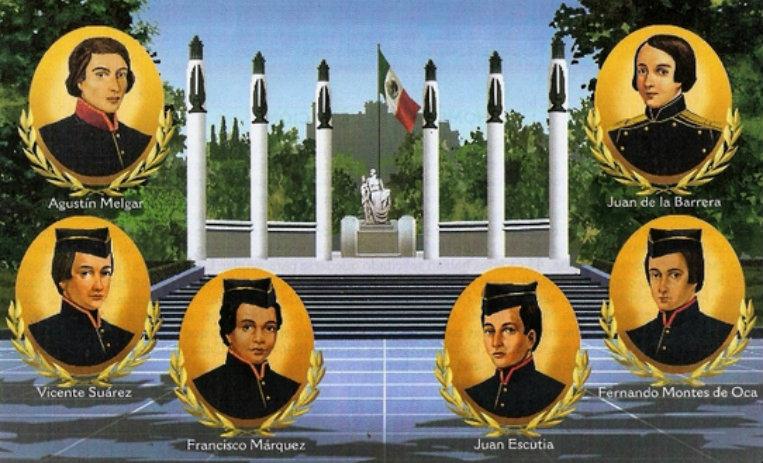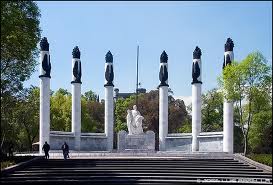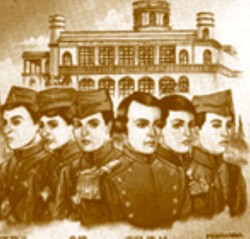By: Patricia Ann Talley, Editor
Mexico Honors its Young Patriots
During September, Mexico remembers and honors six young cadets, ranging in age from thirteen to nineteen, who died defending their military academy at Chapultepec Castle in Mexico City in 1847 during the Mexican-American War, known in Mexico as the “Insurgency from the North.” There is a monument dedicated to these young men.
As United States President Truman said, “Brave men do not belong to any one country.”
Chapultepec Monument in Mexico City honors the fallen cadets. (Photo by Hajor, Mar. 14, 2004.)
The USA Invades Mexico in 1847 following the Texas Revolution
In 1847, then US President James K. Polk sent an army by sea to Veracruz in order to seize Mexico City and to force an end to the bloody, two-year campaign that broke out after the 1845 annexation of Texas, a former Mexican territory. Upon entering Mexico City, US forces outnumbered and quickly overwhelmed the estimated 3,400 soldiers, led by General Antonio López de Santa Anna, who was defending the nation’s capital.
Training Cadets Were Thrust into a REAL War
General Nicolas Bravo was stationed at Chapultepec Castle, atop Chapultepec Hill in Mexico City. Chapultepec Hill held a strategic advantage as its position protected Mexico City on its west side from invaders. Chapultepec Hill is considered by ancient Mesoamericans to be one of the four sacred mountains in the Valley of Mexico. A military academy was located there, and the young cadets were suddenly thrust into a real war when the US military invaded the Chapultepec Castle on September 13, 1847.
The US Marine Anthem that includes the words, “from the halls of Montezuma” refers to the battle at Chapultepec Castle.
Six young cadets gave their lives in defense of their country at Chapultepec Castle in Mexico City when the US military invaded during the Mexican-American War.
When it became apparent that the United States forces were triumphing, General Bravo ordered his men, including the military cadets, to retreat to safety. Six young cadets, however, refused to relinquish their posts and bravely met the superior forces of the American army and marines.
The names of these young men, again only thirteen to nineteen years old, were Juan de la Barrera, Juan Escutia, Francisco Márquez, Agustín Melgar, Fernando Montes de Oca, and Vicente Suárez. They died that September day, defending their country.
According to historical accounts, as the cadets fought to the death, Juan Escutia wrapped himself in the Mexican flag and threw himself from the ramparts to keep it from being captured by the attacking army. The sacrifice of these young men has been forever etched into Mexico’s history.
The invasion of Mexico by the United States has affected the fates of the nations for years. It is the historical basis for many of our immigration problems today.
President Ulysses Grant Called the War as a “Massive Land Grab”
President Ulysses Grant described the war as a massive land grab. He wrote in his memoirs,
“For myself, I was bitterly opposed to the annexation of Texas, and to this day regard the war, which resulted, as one of the most unjust ever waged by a stronger against a weaker nation. It was an instance of a republic following the bad example of European monarchies, in not considering justice in their desire to acquire additional territory.”
(Source: The News, September 13, 2011, Mac Ediciones y Publicaciones S.A. de C.V., Mexico City)
Many prominent Americans, including Abraham Lincoln and John Quincy Adams, considered the war unjust and questioned the rationale for the invasion.
Every September 13, the Mexican president, representatives of the Mexican legislative and judicial branches of the federal government, and current Colegio Miltar cadets lay wreaths to honor the Niños Héroes at the Altar a la Pátria monument, located at the base of Chapultepec Hill. Visiting heads of state often lay wreaths at the monument. It is not common for US presidents to do so, but President Truman had a wreath-laying ceremony in 1947 as did President Clinton in 1997.



